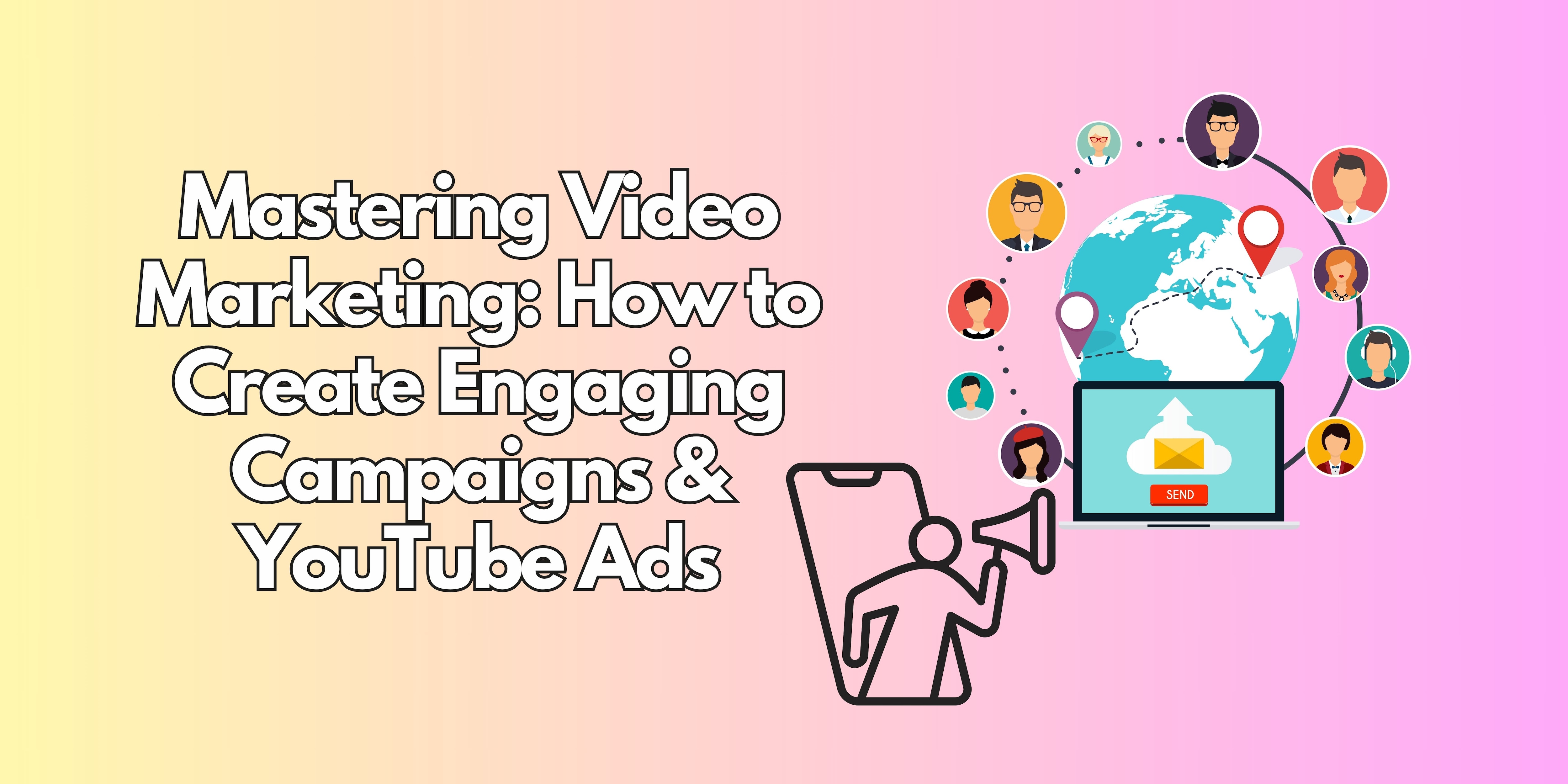
Video marketing has become one of the most powerful tools for brands looking to engage audiences and boost conversions. With the rise of digital content consumption, businesses leverage video marketing strategies to capture attention, build brand awareness, and drive sales. In 2025, video marketing is more relevant than ever, as platforms like YouTube, TikTok, and Instagram continue to dominate online engagement.
Understanding how to create an effective video marketing campaign is crucial for success. From defining goals to optimizing content for search engines, businesses need to craft compelling videos that resonate with their target audience. Additionally, AI-powered tools like Filmora can significantly enhance the video creation process, making it easier to produce high-quality content. This guide will walk you through the essential steps to mastering video marketing, exploring different types of marketing videos, leveraging YouTube ads, and implementing best practices for successful campaigns.
In this article
Part 1: How to Create a Video Marketing Campaign with Filmora
Filmora features an entire set of tools powered by AI which aims to improve the content quality and simplify video editing. This platform is useful not only for professionals, but also for newbies, making it an invaluable part of your video marketing arsenal. Let's examine some of the key aspects it has to offer:
Step-By-Step Guide
Although its features are quite complex, Wondershare Filmora remains intuitive and user-friendly. You’ll not find it hard to initiate certain operations when creating marketing videos. Just ensure that you’re familiar with the workspace and its corresponding navigation. Do you want to give it a try? If that is so, then check out the series of tutorials provided below. Read the instructions very well and follow the indicated steps accordingly.
Create Marketing Videos From a Template
Step 1: Download the Wondershare Filmora application from its official website. Right after, install it on your computer.
Step 2: Run the newly installed video editing software on your desktop afterward. Once it fully loads up, head over to the main dashboard and tap New Project to start editing. Alternatively, scroll down to the Local Projects section and open an existing session if there is any available.
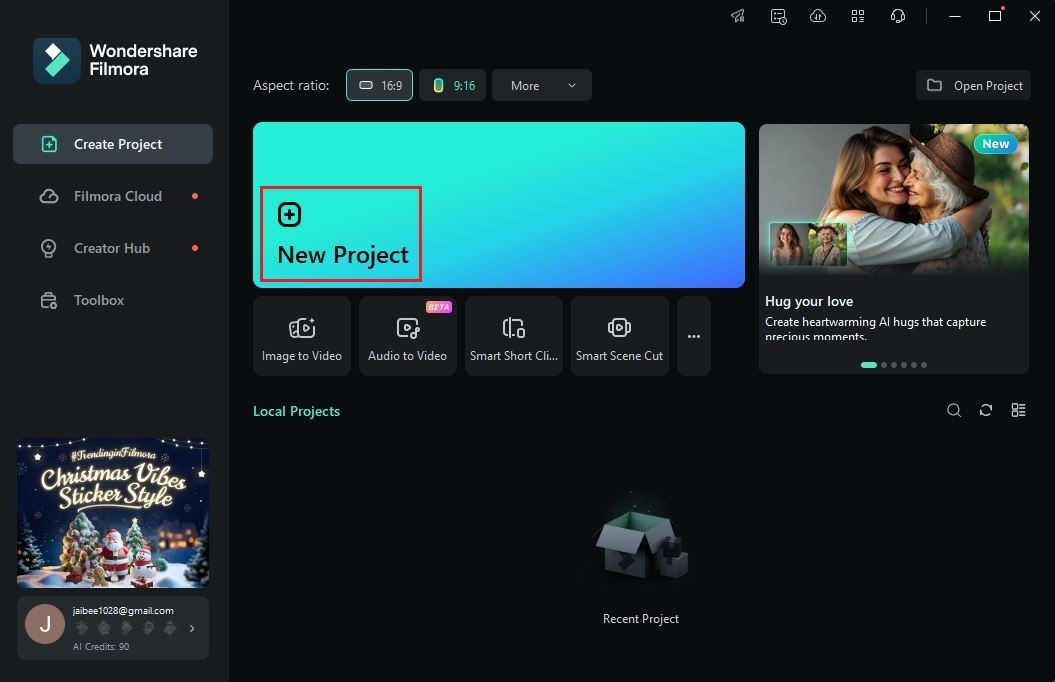
Step 3: After that, navigate to the Elements Panel and click Import under the Media tab. Select all the files you are going to use and then upload them to the platform.

Step 4: At this point, it’s time to select and customize a video template. Don’t worry. It’s a piece of cake. To get started, switch the Elements Panel’s tab from Media to Templates.

Step 5: Browse the available selections or search for a specific type of template you want to use. Choose one based on your preferences and then click its corresponding Download button. Once done, grab the template asset and drag it all the way to the Editor Timeline for further customization.

Step 6: As previously indicated, video templates offered by Wondershare Filmora are editable. Depending on the type of the selected preset, you can edit the text, add imported elements, change the animations, and the like. To do that, simply click the Replace button attached to the asset and then make your desired adjustments.

Step 7: Finally, play and review the output. If you’re satisfied with the result, click the Export button right above the Preview Panel to render the video and save a copy to your computer. Otherwise, continue making adjustments until you achieve a desirable outcome on your end.
Create marketing videos using AI Text To Video
Step 1: On Wondershare Filmora’s main dashboard, find and select AI Text To Video. If it’s not displayed, click the More Options button instead to view the entire collection.

Step 2: A new panel will then open on your computer screen. From there, access the text box and type a text prompt that describes the video you want to create.

Step 3: After that, navigate to the settings section right below the input field and make the necessary adjustments. You may change the default inputs and specify your preferred Voice Language, Voice Style, and Video Aspect Ratio. If you want to use your own voice, tap Clone Voice instead. Once done, tap Text To Video to run your inputs.
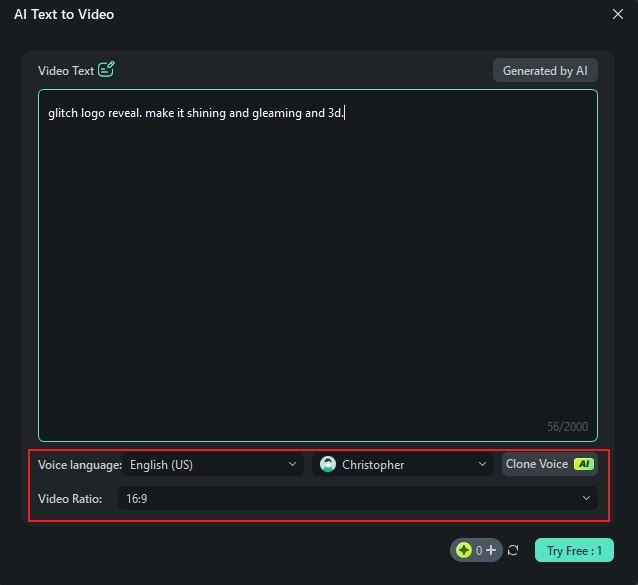
Step 4: Finally, the video will be generated based on the provided description. You may further edit the output using the available tools in the workspace. Once done, click Export to render and save the video.
Advanced Editing Tools
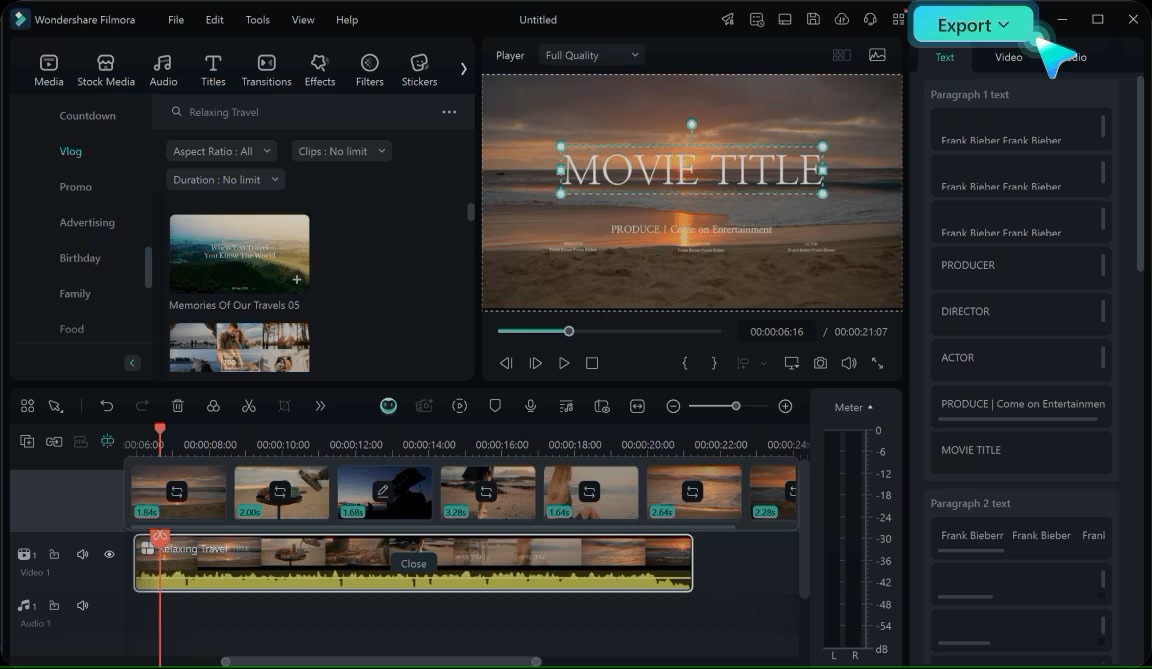
With Filmora, you gain access to an extensive set of editing tools that empowers you to produce cinematic-quality videos. These tools include seamless transitions, dynamic effects, color correction, and other visual enhancements which indeed helps to perfect your video production. The program has ready overlays and animations which enable the user to enhance their content. If you wish to tell a story with suspense or would like to feature a product in an amusing manner, Filmora’s advanced editing has the sophistication to ensure that you have the exact tone and style that you need for your campaign.
AI-Powered Audio Sync
Audio quality is just as important as visual appeal in video marketing. With audio sync powered by AI, Filmora implements the most intelligent video editing tools. It automatically synchronizes your audio tracks with the related video parts to the precise segment. Whether it's for voiceovers, background music or any graphic sound, the platform makes sure it matches the video perfectly and improves the storytelling. By reducing the need for manual adjustments, this feature not only saves valuable time during post-production but also improves the viewer experience by delivering a smooth, immersive audio-visual flow.
Speed Ramping and Split-Screen Options
To add a creative twist to your videos, Filmora offers innovative features like speed ramping and split-screen layouts. Speed ramping enables you to manipulate the pace of your footage, allowing for dramatic slow-motion sequences or dynamic fast-paced effects. This can be particularly effective for highlighting key moments or creating an emotional impact. Additionally, the split-screen option lets you display multiple video clips simultaneously. This feature is excellent for showing differences or changes, before and after images, or other angles of a product or service. With this, you can create compelling videos that will maintain the viewer’s focus and improve the storytelling.
By leveraging these advanced features, Filmora empowers marketers to produce high-quality, engaging video content that not only captures attention but also drives measurable results.
Part 2: Important Tips for Improving Video Marketing
Creating a video marketing campaign requires careful planning and execution. Whether you’re a small business owner or a large corporation, the right approach ensures that your video content resonates with your target audience and drives meaningful results. Follow these steps to craft a compelling video marketing campaign:
Define Your Goals
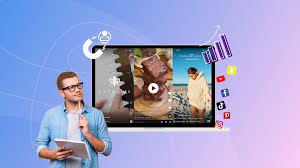
Before producing any video content, establish clear objectives. Are you looking to increase brand awareness, drive website traffic, generate leads, or boost sales?
- Setting clear goals ensures that every video serves a purpose and aligns with your marketing strategy.
- Your goals will determine the type of videos you create, the platforms you use, and the success metrics you track.
Understand Your Target Audience
Knowing your audience is essential for crafting relevant content. Conduct market research to analyze demographics, preferences, and online behavior.
- Identify what type of content your audience engages with most and where they spend their time online (YouTube, Instagram, TikTok, LinkedIn, etc.).
- Address your audience’s pain points and provide value-driven content that keeps them engaged.
Develop a Content Plan
A well-structured content plan outlines the types of videos you will create, their themes, and where they will be distributed.
- Consider leveraging different platforms such as YouTube, Facebook, Instagram, and TikTok to maximize reach.
- Plan content that aligns with your marketing funnel, from awareness-building videos to conversion-focused ads.
- Your content plan should also include a posting schedule, ensuring a consistent flow of content.
- Determine the best times to publish videos based on audience activity, and create a mix of short-form and long-form content to keep engagement high.
- Additionally, plan for interactive elements like polls, Q&A sessions, and live videos to foster a stronger connection with your audience.
Produce High-Quality Videos

The quality of your videos significantly impacts engagement. Invest in good storytelling, clear visuals, and high-quality audio to create professional content.
- Even with limited resources, AI-powered tools like Filmora can help enhance video production with smart templates, effects, and editing features.
- Focus on scriptwriting, scene planning, and post-production refinement to create compelling videos.
- Ensure that your videos have a clear message, smooth transitions, and professional-grade lighting and sound.
- Experiment with different video styles—such as animations, voiceovers, and interviews—to keep your content fresh and appealing to a diverse audience.
Optimize for SEO
Search engine optimization (SEO) plays a crucial role in video visibility. Use relevant keywords, compelling titles, and detailed descriptions to improve rankings on search engines and video platforms like YouTube.
- Incorporate video transcripts, closed captions, and engaging thumbnails to increase discoverability.
- Use tags and categories to help platforms index your videos correctly.
- Encourage audience engagement by prompting viewers to like, comment, and share your videos, as higher engagement rates can boost your content’s ranking.
- Embed videos on your website and share them across social media channels to enhance visibility and drive more traffic to your content.
Part 3: Types of Marketing Videos
A diverse mix of video types is essential to engage audiences at different stages of the buyer’s journey. Each format serves a unique purpose and can be strategically deployed to nurture leads and drive conversions. Here’s an in-depth look at various types of marketing videos:
Explainer Videos

Explainer videos are designed to break down complex concepts or products into easy-to-understand visuals and narratives. Using a mix of animation, voice-over, and on-screen text helps break down complex concepts into uncomplicated, precise messages. These videos, which are usually one to two minutes long, explain the major benefits and features of your product or service. By simplifying complex information, explainer videos not only inform but also build confidence in potential customers, making them more likely to explore your offerings further.
Product Demos

Product demonstration videos provide a hands-on look at how a product works in real-life scenarios. They are particularly effective in showcasing a product’s functionality, key features, and benefits in a manner that static images or written descriptions cannot match. Detailed demos help potential customers visualize how the product fits into their lives, thereby easing any concerns about usability or performance. Whether you opt for a live demonstration or a step-by-step walkthrough, product demos serve as a powerful tool to build trust and facilitate informed purchasing decisions.
Testimonials and Case Studies
Customer testimonials and case study videos are invaluable for building trust and credibility. Featuring real customers sharing their positive experiences, these videos offer social proof that can significantly influence purchasing decisions. Testimonials capture authentic feedback in a relatable format, while case studies delve deeper into specific success stories, illustrating how your product or service has solved real problems. This personal and evidence-based approach can reassure potential buyers by showcasing tangible results and reinforcing the value of your offering.
Brand Storytelling Videos
Brand storytelling videos focus on conveying your company’s mission, values, and unique narrative. By sharing the history behind your brand, the challenges you’ve overcome, and your vision for the future, these videos create an emotional connection with your audience. Storytelling videos help humanize your brand, transforming it from a faceless entity into a relatable and trustworthy presence. This emotional resonance not only boosts brand loyalty but also encourages viewers to engage more deeply with your content and become long-term advocates.
YouTube Ads and Campaigns
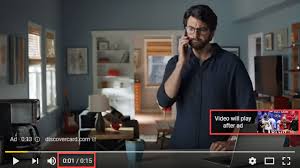
YouTube ads offer a versatile platform for reaching targeted audiences through various advertising formats. Whether you choose skippable ads, non-skippable ads, bumper ads, or sponsored content, each format provides unique benefits in terms of viewer engagement and reach. These ads can be finely targeted based on demographics, interests, and online behavior, ensuring that your message reaches the right people. Furthermore, integrating interactive elements like call-to-action overlays can drive immediate responses, transforming casual viewers into active participants in your marketing funnel.
Each of these video formats can be tailored to different stages of your marketing strategy, ensuring that your campaign effectively addresses the needs and preferences of your target audience.
Part 4: Tips for Successful Video Marketing
Implementing best practices can significantly enhance the effectiveness of video marketing campaigns. Here are some essential tips:
- Keep videos concise and engaging: Attention spans are short, so aim for clear and impactful messaging within the first few seconds.
- Use strong calls-to-action (CTAs): Encourage viewers to take the next step, whether it’s visiting a website, subscribing, or making a purchase.
- Monitor performance metrics: Track key analytics such as watch time, engagement rate, and click-through rates to measure success and refine future strategies.
- Optimize for mobile viewing: Ensure videos are mobile-friendly, as a significant portion of video consumption happens on smartphones.
- Leverage social media for distribution: Promote videos across various platforms to increase reach and engagement.
Conclusion
Video marketing is an essential strategy for businesses looking to engage audiences, drive conversions, and build brand awareness in 2025. With the right approach, companies can create compelling content that resonates with their target audience and delivers measurable results.
From defining clear goals and understanding audience preferences to leveraging AI-powered editing tools like Filmora, businesses have numerous opportunities to enhance their video marketing campaigns. Different types of marketing videos, including explainer videos, product demos, testimonials, and YouTube ads, offer various ways to connect with potential customers.
To stay ahead in the competitive digital landscape, brands must continuously optimize their video content, monitor performance, and adapt to changing consumer behaviors. By implementing best practices such as keeping videos concise, using strong CTAs, and optimizing for SEO, businesses can maximize the impact of their video marketing efforts.
Whether you’re a beginner or an experienced marketer, embracing video marketing strategies and utilizing advanced tools like Filmora can help you create high-quality, engaging content that drives success. Start building your video marketing campaign today and elevate your brand’s digital presence!



 100% Security Verified | No Subscription Required | No Malware
100% Security Verified | No Subscription Required | No Malware

